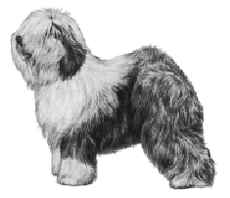Old English Sheepdog
General Information - Old English Sheepdog

Group:
Working
Size:
Medium - large
Lifespan:
10 -12 years
Exercise:
Medium
Grooming:
Very high
Trainability:
Very low
Watchdog Ability:
Very good
Protection Ability:
Medium
Area of Origin:
England
Date of Origin:
1800s
Other Names:
None
Original Function:
Sheep herder
History
Although the origin of the breed is uncertain, the Old English Sheepdog has existed in England for at least two hundred years. The breed likely descended from other European herding dogs that made their way to the British Isles on visiting ships. In earlier times, the breed's temperament was less than sterling which made it a good herding dog in areas where wolves were a threat to flocks of sheep. However, as the breed's role changed from herder to drover.They were best known for droving New Forest ponies to market.So did the temperament. The breed is hardy, intelligent and is still a good worker in some rural areas of England. The English Kennel Club recognised the Old English sheepdog in the 1870s. This beautifully-tempered dog enjoys life in the country over that of the city.
Temperament
Old English Sheepdogs were originally used as herding dogs but nowadays make sweet-tempered family pets. They are sometimes couch potatoes but love nothing more than to play with children. Described as lovable teddy bears Old English Sheepdogs make excellent family pets and may even try to herd children by gently bumping them. Old English Sheepdogs are protective, alert, faithful and gentle.
Upkeep
The Old English Sheepdog needs daily exercise, either a moderate to long walk or a vigorous romp. It particularly enjoys herding. It can live outside only in temperate to cool climates, but it is strongly advised that this breed have access to the house or indoor quarters because it thrives on togetherness. Its coat needs brushing or combing every other day, or it may form mats. It may tend to track in debris.
Old English Sheepdog
A breed standard is the guideline which describes the ideal characteristics, temperament, and appearance of a breed and ensures that the breed is fit for function with soundness essential. Breeders and judges should at all times be careful to avoid obvious conditions and exaggerations, as well as being mindful of features which could be detrimental in any way to the health, welfare or soundness of this breed.
Breed Standard - Old English Sheepdog
 General Appearance:
General Appearance: A strong, compact-looking dog of great symmetry; absolutely free of legginess; profusely coated all over; very elastic in a gallop but in walking or trotting has a characteristic ambling or pacing movement; and his bark should be loud, with a peculiar “pot casse” ring in it. All round the Old English Sheepdog (OES) is a thick-set, muscular, able-bodied dog, with a most intelligent expression, free of all Poodle or Deerhound character.
Head and Skull: Skull capacious and rather squarely formed, giving plenty of room for brain power. The parts over the eyes should be well arched and the whole well-covered with hair. Jaw fairly long, strong, square and truncated; the stop should be defined to avoid a Deerhound face. Nose always black, large and capacious.
Eyes: Dark or wall eyes are to be preferred.
Ears: Small and carried flat to side of head, coated moderately.
Mouth: Teeth strong and large, evenly placed and level.
Neck: The neck should be fairly long, arched gracefully and well coated with hair.
Forequarters: The forelegs should be dead straight, with plenty of bone, holding the body well from the ground, without approaching legginess; well coated all round. The shoulders sloping and narrow at the points, the dog standing lower at the shoulders than at the loin.
Body: Rather short and very compact, ribs well sprung, and brisket deep and capacious. The loin should be very stout and gently arched.
Hindquarters: The hindquarters should be round and muscular, hocks well let down and the hams densely coated with a thick, long jacket in excess of that of any part of the body.
Feet: Small, round; toes well arched, and pads thick and round.
Tail: Customarily docked.
Coat: Profuse, and of good hard texture; not straight, but shaggy and free from curl. The undercoat should be a waterproof pile when not removed by grooming.
Colour: Any shade of grey, grizzle, blue or blue merle, with or without white markings; any shade of brown or sable to be considered distinctly objectionable and not to be encouraged.
Weight and Size:
Dogs: 55.8 cm (22 in) and upwards, slightly less for bitches. Type, symmetry and character of the greatest importance, and on no account to be sacrificed to size alone.
Faults: A long, narrow head.
Note: Male animals should have two apparently normal testicles fully descended into the scrotum.
DNZ No 536
Copyright Dogs New Zealand
19 Dec 2013
Any departure from the foregoing points should be considered a fault and the seriousness with which the fault should be regarded should be in exact proportion to its degree and its effect upon the health and welfare of the dog and on the dog’s ability to perform its traditional work.




